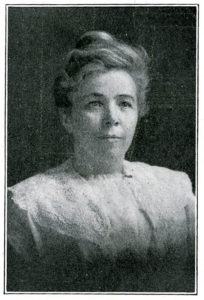In a previous post, I described how Edwards County had many German-Americans with some thriving German-speaking communities. The people who lived around Sts. Peter and Paul Catholic Church north of Kinsley spoke German. As did the Zion Lutheran Church community south of Offerle. Cordelia Gall Froetschner (1918-2011) grew up in that area. During an interview in 2009, she said, “Our church had German services for years, and then as long as there were some of the older members who knew German, there were German services.”
Cordelia’s niece, Marilyn Froetschner Kersting, grew up in the rural neighborhood also. She said in a 2011 interview, “My folks (Harry and Clara Froetschner) understood German. My dad spoke only German until he went to school. All the Froetschner boys did. Maybe Ernest, the youngest, didn’t because they did enough speaking of English by the time he was old enough. But the others, that’s the only language I think they knew until they went to school.”
In the February 8, 1917 edition of the Kinsley Graphic, Pastor Walter Berg of the German Methodist Church located north of Kinsley extended an invitation which points to the fact that German was the first language in that area and accommodation was being made for the English-speaking folk during their services.
“We are endeavoring to adapt ourselves to the needs of the entire community. Among other things we have introduced some services for the benefit of those who cannot understand the German Language. We now have two classes in the Sunday-school that are being conducted in English. The Epworth League (group for young adults, 18-35) and preaching services on Sunday evenings are also in the English language. This will give everyone an opportunity to receive the blessings that a church in a neighborhood brings in the individual and to the home.
Even before WWI, the German language was being taught in Kinsley High School. It was reported in the Kinsley Mercury on January 26, 1917 that a German Club had been organized and was publishing a newspaper. The staff was made up of first, second, and third year students with Olive Maud Stewart as the German and Latin teacher. Ms Stewart received her B.A. from Baker University and Berlin University. Students wrote articles in German on different high school subjects. ”They have recitations, debates, and conversations in the German language and each one of the class contributes a current event in the German language.”
 Olive Maud Stewart, 1917 Kinsley High School Annual
Olive Maud Stewart, 1917 Kinsley High School Annual
The German language was alive and well in Edwards County before the U.S. entered the war. After war was declared, the story changed. At the same time that enemy aliens were being registered, there was an ongoing effort to eradicate German “Kulture” and language. Fear was making Americans suspicious of their neighbors. People began to worry about spies and sabotage. Hearing the German language both reminded people of the enemy that was killing American boys overseas and also aroused suspicions because what they were saying was not understandable to the English-speaking American. In 1918, there was a call made to eliminate the speaking of German in America.
Mary Kallaus came into the library last week and talked about her mother-in-law, Marie Schinstock Kallaus, who had grown up in the Sts. Peter and Paul area. At the time, they had a nun who taught German in the parochial school, but her mother had said that it was stopped in 1918 and never taught again. During those years, the women did not like to go to town because their English was not as good as the men’s who had more contact with English speakers. Mrs. Kallaus had also said that the county attorney, A.L. Moffat, would periodically make visits to the community looking for any suspicious activity.
In January 24, 1918, the Kinsley Graphic reported: “The Teachers’ Council in Topeka last week went on record favoring the expulsion of the German language from all schools, public, private or parochial in Kansas. Chancellor Strong of the University (of Kansas) led the fight on the German language, making an especial plea that the school where all instruction is in German shall teach the English.
It was ten weeks before the Kinsley School Board “decided to cut out the teaching of the German language in our city schools next year.” Kinsley Graphic, April 4, 1918
That summer the Graphic wrote that the German teacher, Olive Maud Stewart, was moving to Cimarron. The Cimarron Record subsequently reported her arrival in Cimarron where she was to take over the duties of principal. She was no longer teaching German.
When the United States entered World War II, anti-German sentiments would be rekindled. A look through the Kinsley High School annuals shows that Latin, Spanish and French were the only languages taught at various times since 1918. The German Language was never again part of the curriculum.
